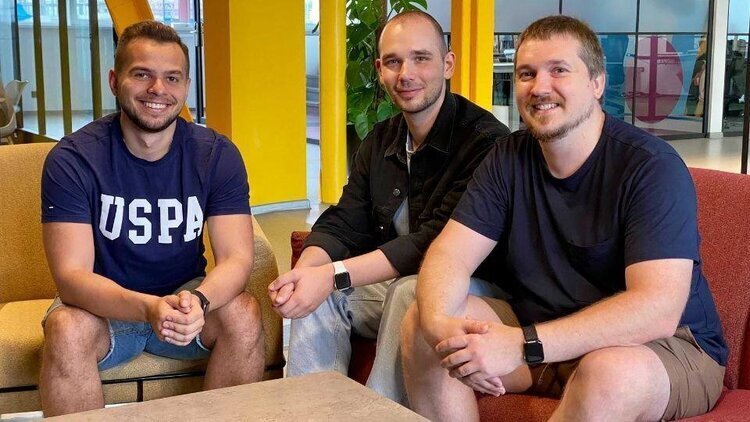$900,000 of investments: How Ukrainian startup Workee raised such funds and increased the number of users almost fivefold in a month
And why the team changed the monetisation model
Recently, the Ukrainian startup Workee raised $900,000 in funding. The investors involved were international funds as well as Google's special fund. According to Workee, the post-money valuation reached $9–12 million. Where will the raised funds go? Who is the startup targeting? How does Workee attract clients and how effectively? How has it managed to reach out to 70 countries worldwide? Igor Bauman, co-founder of Workee, shared this with Mind.

What is Workee? In 2020, three entrepreneurs – Ighor Bauman, Yevgen Kyseliov, and Artem Kanaki – created Workee. They developed a system that helps freelancers work directly with their clients on a single platform.
Bauman refers to their clients as freelance professionals: "Workee is the next step after the marketplace. When freelancers start their careers, they go to platforms like Upwork to get their first clients. The service takes about 30% commission from each transaction. Over time, freelancers build their own client base. To work directly with them, they need Workee."
This service allows users to create a personal website, fill it with content, and includes built-in booking systems, calendars, video calls, and payment options. Currently, the annual subscription fee is $290. The startup does not charge any additional transaction fees. Are there any plans for them in the future? "Yes, there are," says the co-founder.

What about the team? Currently, there are 14 individuals 'in the game'. However, the startup is actively hiring more employees. The team works from different continents: employees are based in the USA, Portugal, Spain, Croatia, Nigeria, the Philippines, Poland, and Ukraine (Kyiv). Igor Bauman is responsible for the product, marketing, partnerships, investments, and operational aspects. Artem Kanaki oversees the technical aspects, architecture, integrations, and DevOps. Yevgen Kyseliov is in charge of design, product vision, and marketing.
How do they attract clients? There are several channels, including paid advertising, social media, and paid search. "On our website, we have a considerable blog where we provide a lot of content. We collaborate with bloggers, thought leaders, experts for interviews and write reviews about Workee," Bauman explains.
Another funnel for client acquisition is through partnerships. "We help our clients open financial accounts in the United States. We also partner with a legal company that assists our clients in registering their legal entity in the USA," the interviewee explains.
Why did they change the business model? From the very beginning, the startup offered a free solution for 30 days, followed by a paid version. "Our partners always pushed us to show revenue. Everything was going well, but we realised that our monthly growth was not as ambitious as we wanted it to be," recalls Bauman.
So, in the middle of 2022, the team decided to switch to a Freemium model, introducing subscriptions. After this change, the metrics started to improve. In the first month, according to the co-founder, the user base jumped from 1,500 to 7,000 users. "The essence of the decision to change the business model was to grow the customer and user base. We gained a strong group of users who constantly recommended us to their friends and partners. This allowed us to grow more globally," recalls the co-founder.
Which markets are they targeting? The main 'launchpad' is the USA. However, today the solution is used in more than 70 countries worldwide. "We didn't specifically target them, but by aiming for a more global effect, we managed to build autonomous channels of growth. At the same time, we are testing the markets in Canada, Australia, and Asia because users naturally come to us from these regions," explains the co-founder.
How much has been invested in the product? Overall, the startup has received a total investment of $1.6 million. Initially, the founders invested approximately $100,000 of their funds. After that, they won a grant from UFS and joined the Startup Wise Guys accelerator. Subsequently, they closed a pre-seed round of $600,000, with investors including the Czech fund Lighthouse Ventures, Startup Wise Guys accelerator, and Igor Makhanok, the co-founder of GEEK Ventures.
SMOK Ventures, Slava Ventures, a California-based fund focused on Ukrainian projects, and several Silicon Valley angel investors, whose names have not been disclosed, participated in Workee's recent investment round. Formally, the startup has received $800,000 in investment, as the $900,000 amount includes a grant from the Google for Startups Ukraine Support Fund. Google's exact share is not disclosed, but the maximum grant amount is usually $100,000.
"We are currently in between pre-seed and seed rounds. I can't call it a full-fledged seed round. We didn't actively seek investors; we had long-standing relationships with all of them. So, we didn't spend much time fundraising and simply decided to team up with people who shared the same values. They can support our business in terms of partnerships, the right interactions, and expertise," says Bauman.
Where will the raised funds go? The standard plan for the team is to invest in R&D and marketing. "We will boost our current channels and strengthen our development," says Bauman.
How does the team plan to increase performance? At the beginning of February 2022, the founders had ambitious plans: to triple the team's size and increase the number of users by 14 times, reaching 50,000 users. Why weren't they successful? "There are several reasons, but I won't mention all of them. I'll tell you the obvious one. There was a war, and the main team was in Ukraine. Our progress was frozen for further four to five months," says Bauman.
The marketing department was not operational during this time. When the team started getting back to work, they made a pivot towards a different audience and shifted their focus from the number of users to quality. "That's why we revised our plans, reinitiated monetisation. Now we are moving according to the plan," says Bauman.
Now the team plans to increase revenue by 70–100% per month and reach 15,000 users by the end of 2023. "We actively analyse how monetisation is progressing and expand marketing efforts in the channels that work for customer acquisition," explains the co-founder.
The startup is preparing a partnership to be announced in August with an institution in the US. "This will give us a boost in users," Bauman believes. At the same time, the team is receiving requests from B2B clients for a Workee teams model, which the startup is still working on. "Therefore, all three of these main areas will allow us to support our plans and reach our goals," the co-founder hopes.
What else is on the agenda? Becoming the primary solution for freelancers to manage their business online. "Freelancers eventually need to handle their accounting, pay taxes, and build their business," says Bauman. The team is going to reach new audiences and markets, launch solutions for businesses, and scale the business model for various types of subscriptions. Potentially, they want to create a platform where freelancers can connect and work with each other.
If you have read this article to the end, we hope that means it was useful for you.
We work to ensure that our journalistic and analytical work is of high quality, and we strive to perform it as competently as possible. This also requires financial independence. Support us for only UAH 196 per month.
Become a Mind subscriber for just USD 5 per month and support the development of independent business journalism!
You can unsubscribe at any time in your LIQPAY account or by sending us an email: [email protected]



